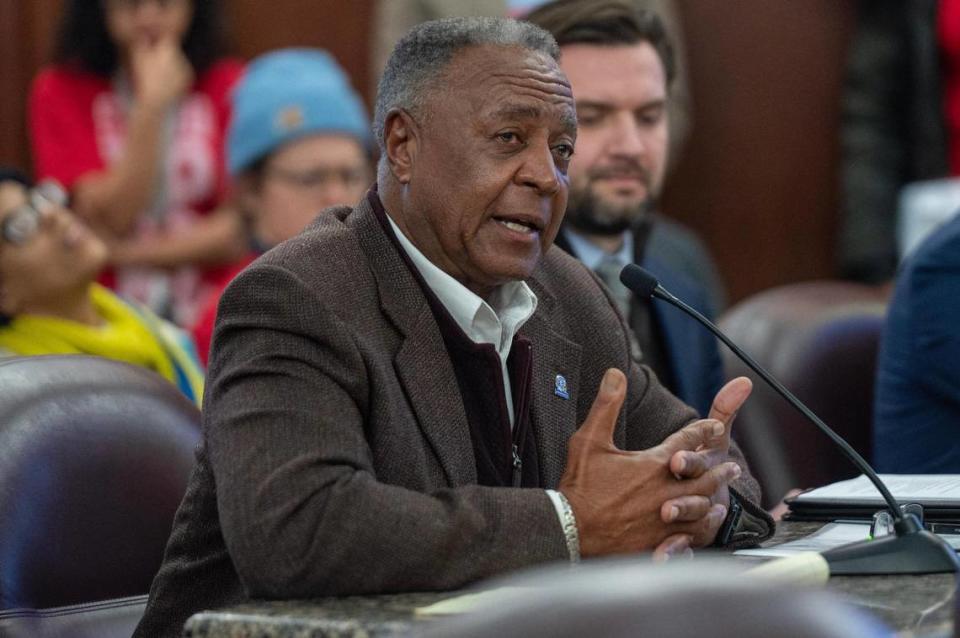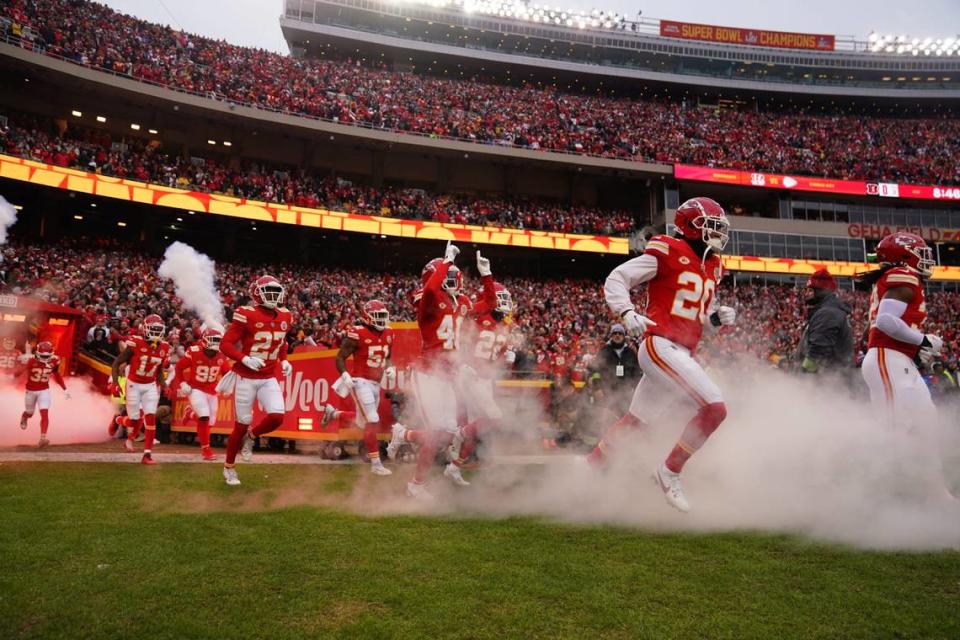Chiefs plan to stay put at Arrowhead, but will they build a practice facility elsewhere?
Reality Check is a Star series holding those in power to account and shining a light on their decisions. Have a suggestion for a future story? Email realitycheck@kcstar.com.
The Chiefs promise to remain in Kansas City, if Jackson County voters approve a sales tax extension that would provide hundreds of millions of dollars to renovate Arrowhead Stadium.
But the organization won’t say whether the team will keep its headquarters and training facility in Jackson County, let alone the Truman Sports Complex, a concern the county executive raised.
Might Chiefs CEO Clark Hunt instead follow the lead of other NFL owners and move those assets off site to create a separate, year-round tourist attraction elsewhere in the metro area? Somewhere fans could watch the three-time Super Bowl champs in action during training camp, ogle team memorabilia and empty their wallets on food, gear and hotel rooms?
Maybe in Johnson County, or on that land the Royals were eyeing for a ballpark in North Kansas City before committing to moving downtown. Both have come up as possibilities, according to local officials, as team officials have privately questioned the economics of adding retail, office and other non-football development at Truman.
“Although we’ve heard rumors about the interest of the Chiefs, the county has not been approached by the team or anyone else to suggest that it is being considered for development,” Clay County commissioners Scott Walker said of the North Kansas City site.
Kansas set aside up to $10 million last year in a fund as part of sports betting legislation to lure professional sports teams to the state, which was widely seen as a gesture directed at the Chiefs. The Kansas Department of Commerce did not respond to a request for comment this week on whether the state has been in talks with the team.
The Chiefs, likewise, declined comment when The Star asked Chiefs management about their intentions.
But Jackson County Executive Frank White Jr. thinks it’s a serious enough possibility that the team will look elsewhere to develop that he urged county legislators on Monday to hold off on approving a ballot measure for extending the stadiums sales tax another 40 years.
White wanted more time to “secure a commitment that both teams maintain their front offices and training facilities in Jackson County for the duration of the lease.”
Absent that commitment, he fears Jackson County might miss out on the tax revenue and economic activity such a development would generate.
“As we contemplate a new 40-year sales tax that will generate billions for the team’s sole use,” he told the Star on Thursday, “it is reasonable and prudent to expect these benefits to directly reach and rejuvenate our community. We are not just retaining a sports team; we are opening doors to a future where sports investment translates into community prosperity, economic growth and an enhanced quality of life.”

Diminished leverage
But White has lost some of his negotiating leverage after the legislature approved the ballot language before getting any promises from the Chiefs about the future location of its headquarters and training center.
Where they will end up is one of several key questions that need answers between now and April 2. That’s when Jackson County voters will decide whether to extend the current 3/8th-cent stadiums sales tax for another 40 years, for both the Chiefs and the Royals.
Among the most obvious and crucial unanswered questions: Where downtown would the proposed new baseball park be located, would it cost more or less than the $1 billion the Royals have estimated, and where will the rest of the money come to pay for it, as the sales tax won’t cover it all?
And as for the Chiefs, how exactly would the team use the hundreds of millions of taxpayer dollars the sales tax would provide other than to finance the “extensive renovations” to Arrowhead that the Royals and Chiefs joint statement last week promised?
White didn’t single out the Chiefs in his statement, but it was aimed at them, as only the Chiefs have a separate practice facility at Truman and have been discussing the need to replace it.
And only in the NFL, not Major League Baseball, has the trend been for teams to locate their headquarters and practice facilities in tourist-friendly developments that they control miles away from their home stadiums.
With 81 home games a year, baseball stadiums draw crowds often enough during the season to justify building entertainment districts around them, as the Royals have said they would like to do.
But NFL stadiums largely stand lifeless, except for the occasional Taylor Swift concert and the 10 days a year that the teams play regular and pre-season home games.
Nine, if they are hosting a contest off shore, as the Chiefs did in Germany this season. A dozen tops, if they go all the way in the playoffs with homefield advantage, as Kansas City did last season.
Many of the Chief’s competitors have been addressing their desire to gain more non-game-day revenue by building complexes miles away from their stadiums where their business and sports operations adjoin practice facilities and tourist attractions that celebrate the team.
Cowboys cash in
The Star District, the Dallas Cowboy’s 91-acre campus in Frisco, Texas, is one of the prime examples.
“It’s like a full-on Cowboys theme park with eating, shopping and hard-core fan-boying unlike anywhere else in America,” according to podcaster Chet Garner, whose The Daytripper videos focus on Texas attractions.
The complex is 37 highway miles north of AT&T Stadium, where the team plays home games in Arlington, Texas. In addition to the team’s headquarters and a hall of fame, The Star’s centerpiece is the indoor, 12,000-seat stadium known as the Ford Center — the automaker bought the naming rights.
Opened in 2016, the Ford Center is where the Cowboys hold training camp and practice in air conditioned comfort. And it’s where the Whataburger fast-food chain sponsors a series of high school football games on Friday nights.
The Star also includes a 300-room hotel, shops, restaurants and the Baylor Scott & White Sports Therapy & Research Center.
Vikings Lakes
The Minnesota Vikings recently built a new headquarters and training facility at the Vikings Lakes development in Eagan, Minnesota, 12 miles southeast of U.S. Bank Stadium in downtown Minneapolis.
The Wilf family owns the team and Viking Lakes. In addition to the team’s headquarters and practice facility that occupy 40 acres of the 200-acre site, Viking Lakes includes, like The Star, an Omni Hotel, apartments, offices and retail.
Raiders and Broncos
After bouncing back and forth between Oakland and Los Angeles over the decades, the Raiders relocated to Las Vegas in 2020.
They play their home games at the $1.9 billion domed Allegiant Stadium on the south end of the Las Vegas Strip, but the team’s $75 million headquarters and training center is 15 miles away, in Henderson, Nevada.
The Denver Broncos have long had an off-site practice facility. But in November, the team announced plans to move the headquarters staff of more than 70 employees from Empower Field at Mile High stadium near downtown Denver to suburban Englewood, Colorado, 18 miles to the south.
Broncos teams have trained in Englewood since 1990. But in addition to building a new headquarters there, the Broncos plan to replace the training center with a larger one that will have more space for the players, along with new amenities and seating areas for fans to watch training camp.
According to the team, the project is privately funded.

Chiefs’ facilities rank low
Kansas City built the Chiefs their first practice field in Swope Park when coach Hank Stram and his squad relocated from Dallas in 1963 and began playing at Municipal Stadium.
While the clubhouse was still under construction that first season, players changed clothes backstage at nearby Starlight Theater.
Chiefs practices moved to Arrowhead when the Truman Sports Complex opened in 1972. Grass practice fields were added in the 1980s elsewhere in the complex, because they were easier on the players’ bodies than the stadium’s artificial turf.
But workouts didn’t move indoors and out of the heat and cold until the current practice facility, which also has three outdoor fields, opened in 1991. It was updated along with the stadium in the late 2000s, but is far from being state-of-the-art these days.
In a survey of 1,300 NFL players last off season about working conditions, the Chiefs came in 29th out of 32 teams. Practice facilities helped hold down the ranking. Chiefs players gave the team’s weight room a C+ grade, while the training and locker rooms were rated D+ and D-, respectively.
“The lockers are old and in desperate need of a renovation,” according to NFLPA’s Chiefs report card. “Many players complain that they want to have a chair at their locker instead of a stool so they can lean back when sitting.”
It was no surprise that the Vikings, Cowboys and Raiders were in the top five, along with the Miami Dolphins and Houston Texans, which also have newer facilities.
Commenting on the rankings last spring, Chiefs head coach Andy Reid agreed that his team did not have the fanciest facilities, as he put it, but said the Chiefs were eyeing a new one rather than a remodel.
“There are future plans for whatever direction it goes for new facilities,” Reid said. “You’re not gonna take and put a whole load (of money) back into your facilities that you have here if there’s future plans.”
And what are those plans? The Chiefs are no comment for now.
Future of the Chiefs in Jackson County
But White has not given up on his attempt to get the team to commit to a project, if not at the sports complex, then in nearby communities in eastern Jackson County.
“We stand at a pivotal moment where the decision to keep the Chiefs’ headquarters and training facility in Jackson County can significantly shape our community’s future,” he said in a prepared statement on Thursday.
“For cities like Independence, still grappling with the decline of the Independence Center, this development could be a lifeline, injecting new life and economic activity. In Lee’s Summit, the proximity to the Rock Island Trail offers a unique opportunity to blend sports, recreation and lifestyle, potentially enabling residents to walk or bike safely to the stadium on game days.”
The teams have until Jan. 20 to provide the county with answers to the questions on this and other topics still swirling in the form of term sheets laying out the basic conditions of the leases they would later sign before any ballots are cast.
But for now it’s far from certain whether the final Chiefs lease will require the team to maintain its presence in Jackson County other than on game days.

